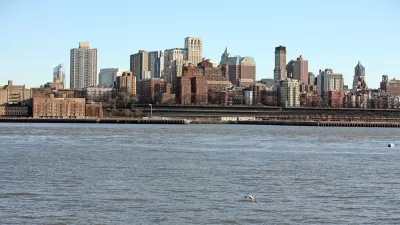An exhibition opening at the Museum of Modern Art this weekend presents a comprehensive review of the career of Le Corbusier, one of the most influential and controversial architects of the 20th Century. How will it change perceptions of his work?
In previewing the exhibition, Anthony Flint, who is authoring a book on Le Corbusier scheduled for publication next year, compares the former Charles-Édouard Jeanneret-Gris to Robert Moses, a similarly reviled figure who received a "thorough revisiting" in a recent exhibition.
"Like Moses, the Swiss-born visionary of modern architecture is also widely disparaged, by New Urbanists and traditionalists involved in any way in the world of urban planning and urban design," he writes. "Le Corbusier is blamed for the 'towers in the park' of ill-fated public housing projects in cities across America, the devastating slum clearance of mid-century urban renewal, and elevated urban freeways that are being systematically dismantled to this day."
"'Le Corbusier: An Atlas of Modern Landscapes,' on view from June 15 to September 23, is an engaging packaging of the career of this innovative designer and artist, tracing a journey from a watchmaking capital in northwest Switzerland to Paris, South America, the Soviet Union, India, and beyond," explains Flint. "It may not change the minds of those who believe that his ideas led to permanent damage for the American city, but the sweeping exhibition provides important insight into the puzzles Le Corbusier was trying to solve in the first place."
Flint points to Corbusier's work that predates "certain aspects of green building" and the contemporary affinity for micro-housing as elements that may garner the architect more positive attention. However, he concludes, "One leaves the show with a thorough sense of the man, and that may be its greatest accomplishment."
FULL STORY: MoMA Pays Tribute to the Terrifying Beauty of Le Corbusier

Maui's Vacation Rental Debate Turns Ugly
Verbal attacks, misinformation campaigns and fistfights plague a high-stakes debate to convert thousands of vacation rentals into long-term housing.

Planetizen Federal Action Tracker
A weekly monitor of how Trump’s orders and actions are impacting planners and planning in America.

In Urban Planning, AI Prompting Could be the New Design Thinking
Creativity has long been key to great urban design. What if we see AI as our new creative partner?

Massachusetts Budget Helps Close MBTA Budget Gap
The budget signed by Gov. Maura Healey includes $470 million in MBTA funding for the next fiscal year.

Milwaukee Launches Vision Zero Plan
Seven years after the city signed its Complete Streets Policy, the city is doubling down on its efforts to eliminate traffic deaths.

Portland Raises Parking Fees to Pay for Street Maintenance
The city is struggling to bridge a massive budget gap at the Bureau of Transportation, which largely depleted its reserves during the Civd-19 pandemic.
Urban Design for Planners 1: Software Tools
This six-course series explores essential urban design concepts using open source software and equips planners with the tools they need to participate fully in the urban design process.
Planning for Universal Design
Learn the tools for implementing Universal Design in planning regulations.
Gallatin County Department of Planning & Community Development
Heyer Gruel & Associates PA
JM Goldson LLC
City of Camden Redevelopment Agency
City of Astoria
Transportation Research & Education Center (TREC) at Portland State University
Jefferson Parish Government
Camden Redevelopment Agency
City of Claremont



























